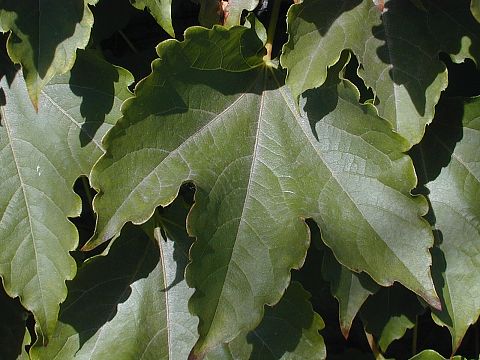Description: This woody vine branches occasionally and can reach 50' in length. Boston Ivy can easily climb tree bark, wooden fences, concrete masonry, and brick or stone walls. In the absence of such supportive surfaces, it sprawls across the ground. The lower stems of mature vines are brown and woody; they can span several inches across and form small brown rootlets that can cling to various surfaces. The upper stems are hairless and vary in color from green to bright orange-red; they produce branched tendrils that have suckers at their tips. These suckers are shaped like small disks and can cling to various surfaces as well. Immature plants that are beginning to develop have trifoliate leaves. However, mature plants produce simple alternate leaves along their stems. The mature leaves span up to 6" long and across (excluding the petioles). They are cordate-oval, palmately lobed (usually with 3 lobes), and crenate or slightly undulate along the margins. Their upper surface is medium to dark green, hairless, and rather shiny. Young leaves of mature plants are similar, except they are yellowish green and coarsely dentate along the margins. The petioles of these leaves are long and slender; they are usually light green, but may become bright orange-red during the fall.

Occasionally,
cymes of flowers are produced from the axils of the leaves. Each cyme
can span up to 4" across and long. Each yellowish green flower is about
¼" across, consisting of 5 green petals, 5 stamens with yellow anthers,
and a central pistil. The sepals are absent or insignificant. The
blooming period occurs during the summer and lasts about 2-3 weeks. The
flowers are usually well-hidden in the foliage. Each fertilized flower
can produce a juicy berry about 1/3" (8 mm.) long that contains 1-3
seeds. The
berries are dark blue with a whitish bloom and globoid in shape; their
stalks are yellowish green, brownish green, or dull orange-red. The
root system consists of a stout woody taproot.
Cultivation:
Boston Ivy prefers full sun to light shade, slightly moist to slightly
dry conditions, and a fertile loamy soil to support its rampant growth.
It will tolerate soil containing clay or stony material. Flowers and
berries are more likely to be produced if there is some exposure to
sunlight.
Range & Habitat:
While commonly planted as an ornamental vine, the non-native Boston Ivy
has rarely
naturalized in the wild in Illinois. According to official records, it
has naturalized in Hancock and Kane counties; the webmaster has
observed escaped plants within the city of Urbana, Champaign County
(see Distribution
Map). Habitats include areas along railroads (including the
gravel ballast) and areas along bridges. Boston Ivy is originally from
East
Asia. It is rather surprising that this introduced vine hasn't
naturalized in more areas of the state, as it is a rampant grower and
produces berries readily. However, some cultivars may be more
productive of flowers and berries than others.
(including the
gravel ballast) and areas along bridges. Boston Ivy is originally from
East
Asia. It is rather surprising that this introduced vine hasn't
naturalized in more areas of the state, as it is a rampant grower and
produces berries readily. However, some cultivars may be more
productive of flowers and berries than others.
Photographic Location:
Along the brick wall of a building in Urbana, Illinois. Nearby, escaped
plants of Boston Ivy were growing near an old bridge that spanned a
large drainage ditch. Some of the vines were clinging to the concrete
masonry of this bridge.
Faunal Associations:
Information about floral-faunal relations are unavailable for North
America. However, it is likely that they are similar to the
floral-faunal relations of Parthenocissus quinquefolia
(Virginia Creeper). In particular, the berries of Boston Ivy are
occasionally
eaten by songbirds, which can disperse the seeds to new locations.
Comments:
Both the foliage and berries are attractive, especially when growing
along the walls of a building. However, because this woody vine is
originally from East Asia, it shouldn't be introduced into natural
areas where native species could be displaced. Boston Ivy is fairly
easy to distinguish from Parthenocissus quinquefolia
(Virginia Creeper), because the mature leaves of the latter are
palmately compound (usually with 5-9 leaflets) and the stalks of its
mature berries are bright orange-red. The mature leaves of Boston Ivy
are simple and the stalks of its berries are less colorful. Both of
these species produce suckered tendrils. It is possible to confuse
Boston Ivy with many Vitis spp. (Wild Grapes)
because they are woody vines that produce simple leaves with 3-5 lobes.
However, the tendrils of Wild Grapes don't produce disk-shaped suckers
at their tips. Furthermore, the flowers of Wild Grape have a different
appearance: They are golden yellow from their strongly exerted stamens,
while their petals are much reduced in size and insignificant. Like
Virginia Creeper, the flowers of Boston Ivy have conspicuous green
petals that resemble sepals.